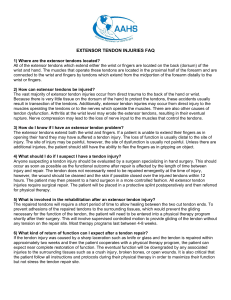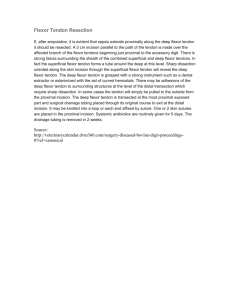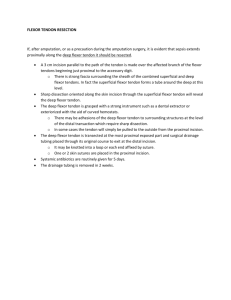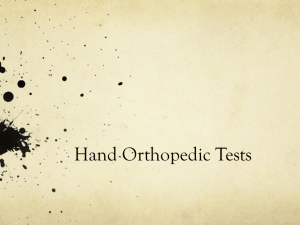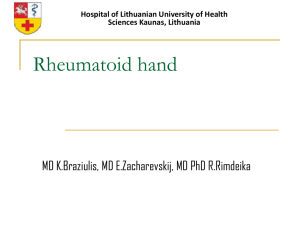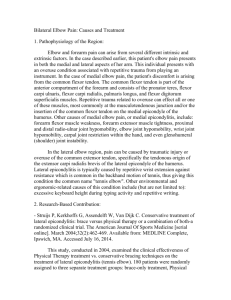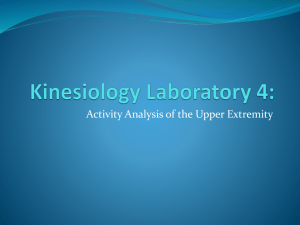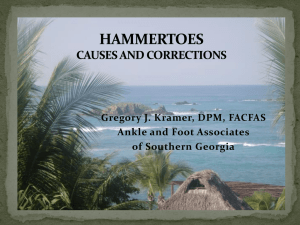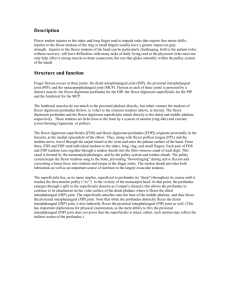Wist and Hand
advertisement
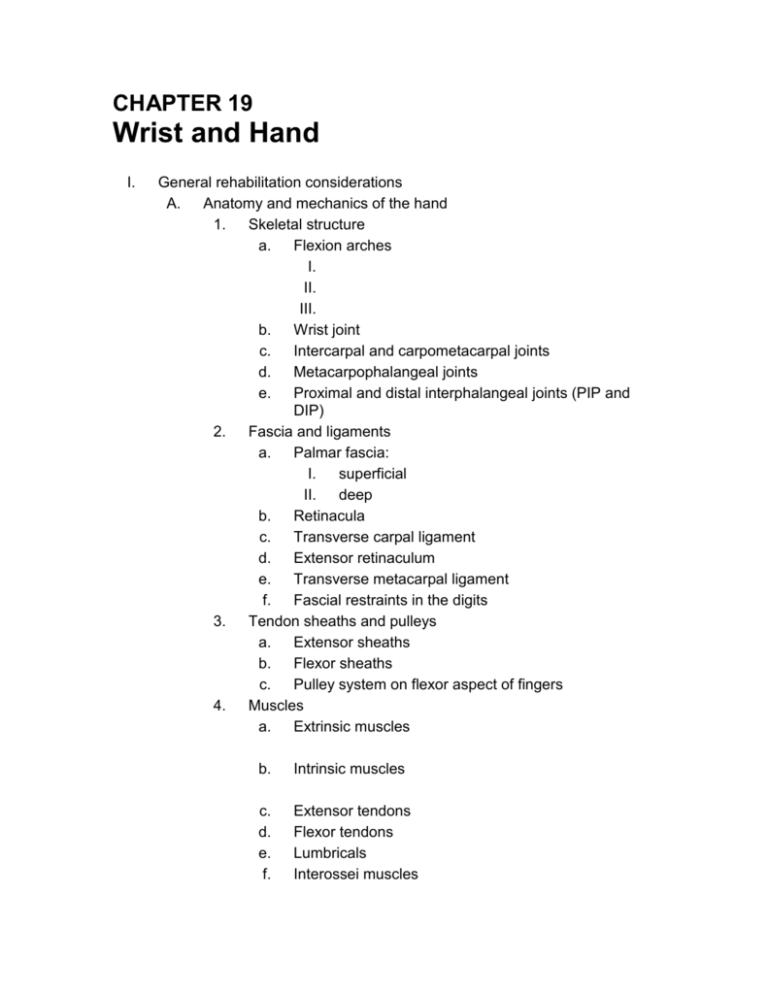
CHAPTER 19 Wrist and Hand I. General rehabilitation considerations A. Anatomy and mechanics of the hand 1. Skeletal structure a. Flexion arches I. II. III. b. Wrist joint c. Intercarpal and carpometacarpal joints d. Metacarpophalangeal joints e. Proximal and distal interphalangeal joints (PIP and DIP) 2. Fascia and ligaments a. Palmar fascia: I. superficial II. deep b. Retinacula c. Transverse carpal ligament d. Extensor retinaculum e. Transverse metacarpal ligament f. Fascial restraints in the digits 3. Tendon sheaths and pulleys a. Extensor sheaths b. Flexor sheaths c. Pulley system on flexor aspect of fingers 4. Muscles a. Extrinsic muscles b. Intrinsic muscles c. d. e. f. Extensor tendons Flexor tendons Lumbricals Interossei muscles B. Edema 1. Problems a. Edema frequently accumulates b. Can lead to c. Excessive swelling on __________ of hand can cause hand arches to _______________ anteriorly and ____________ the thumb d. e. 2. C. D. E. Implications for clinicians a. b. c. Tendon zones 1. Flexor tendon zones a. Zones V, IV, III, II, I b. Thumb zones: TI, TII, TIII 2. Extensor tendon zones a. Zones VII, VI, V, IV, III, II, I b. Thumb zones: TI, TII, TIII, TIV, TV Excursions 1. 2. Normal excursion of tendons: Bunnell's values (see table 19.1) 3. Safe tendon glide excursion during immobilization: 4. Amount of movement permitted with ____ mm of movement for each digit 5. Implications for rehabilitation clinician a. b. Use of the hand 1. Power, or palmar, grips a. b. c. d. 2. F. Prehensile, or precision, pinches a. b. c. Splinting 1. Purpose a. b. c. 2. Three-point pressure system 3. 4. 5. 6. 7. Amount of time splint kept on Static splints Dynamic splints Interaction of fit, design, and purpose of splints Precautions a. b. II. Soft-tissue mobilization A. Extrinsic muscles 1. palmaris longus, 2. pronator teres, 3. wrist/long finger flexors, 4. long finger extensors B. Intrinsic muscles 1. thumb muscles, 2. interossei, 3. abductor digiti minimi, 4. palmar fascia III. Joint mobilization A. Distal radioulnar joint 1. longitudinal traction, 2. AP and PA glides B. Wrist joint 1. traction, dorsal, volar, radial, ulnar, specific carpal C. D. IV. Carpometacarpal joints 1. traction, 2. PA and AP, 3. rotation Metacarpophalangeal and interphalangeal (IP) joints 1. traction, 2. PA and AP, 3. rotation Flexibility exercises A. Joints and ligaments 1. General principles a. Apply mobilization techniques before joints are _______________ b. Stretch one joint at a time c. Keep other joints in neutral and relaxed to reduce d. Application of stretch force: 2. B. C. Stretches a. Abduction movements b. Stretching the metacarpal joints c. Wrist stretches d. Distal radioulnar joint stretches e. Stretching the oblique retinacular ligament Extrinsic muscles 1. General principles a. Begin with the _____________ joint and proceed in sequence _____________ to _______________ b. Apply force _____________ and ______________ c. Contract-relax-stretch techniques d. Apply slight __________ force on joints 2. Stretches Intrinsic muscles V. Strengthening exercises A. Tendon glide exercises 1. General principles a. b. c. d. The effectiveness of these exercises is limited by the muscle's strength and endurance 2. Exercises B. Resistive exercises 1. wrist extension/flexion, 2. ulnar/radial deviation, 3. pronation/supination, 4. putty, 5. grip, 6. opposition, 7. adduction, 8. finger extension, 9. thumb/finger abduction, 10. extensor lag, 11. isokinetic exercise VI. Plyometric exercises A. Plyometric exercises for the shoulder and elbow are also used for the wrist and hand B. Additional exercises VII. Functional activities A. Determined by the demands of the patient's sport/position B. Range of demands: 1. varying grips, 2. varying positions, 3. rapid or slow movements, 4. sustained or changing grips, 5. forceful or light grasping VIII. Special rehabilitation applications A. Fractures 1. General principles a. b. Immobilization is often maintained for ____ to ____ weeks unless the fracture is unstable, displaced, or comminuted c. Open reduction and internal fixation is used with ___________ fractures d. Immobilization used for only as many joints as necessary to stabilize fracture 2. Distal forearm and wrist fractures a. Colles fracture b. Smith's fracture c. Barton's fracture B. 3. Carpal and metacarpal fractures a. Scaphoid b. Bennett's fracture 4. Phalangeal fractures a. Proximal versus middle phalanx fractures b. Adhesions of tendons: possible complication of phalangeal immobilization Dislocations and sprains 1. General principles a. Differences between dislocations and sprains — b. 2. Dislocations occur most often in ____ joints, especially _________ c. Finger sprain is also referred to as a "____________" finger d. Unstable dislocations require surgical repair Program considerations a. Unstable dislocations b. Stable dislocations I. immobilized with the PIP joint in ____° to ____° of flexion C. Overuse injuries 1. Carpal tunnel syndrome 2. D. De Quervain's disease Tendon injuries 1. General principles a. Tendon ____________ exercises are key to preventing adhesions b. Tendon ____________ must be possible before resistive exercises begin 2. Differences between flexor and extensor tendons a. Majority of flexor tendon length is enclosed in a __________________________; extensors are __________________________ b. Flexor tendons have a strong ___________ system; extensors do __________ c. Finger flexion strength is _____________ than extension strength d. Extensor tendons are ___________ and __________ than flexor tendons e. Extensor tendons have ______ tensile strength than flexor tendons f. Loss of extensor tendon mobility is more _________________ than flexor tendon loss g. Loss of extensor tendon mobility more ____________ affects intrinsic muscle function 3. Program progression a. Flexor tendons b. E. Extensor tendons, including boutonniere deformity RSD 1. Program considerations a. Is a __________________ system response to injury b. Early intervention necessary for successful treatment c. Modalities used to control I. II. III. d. e. f. Exercises should be ____________ and light Passive exercises are applied with caution after pain decreases Splinting
